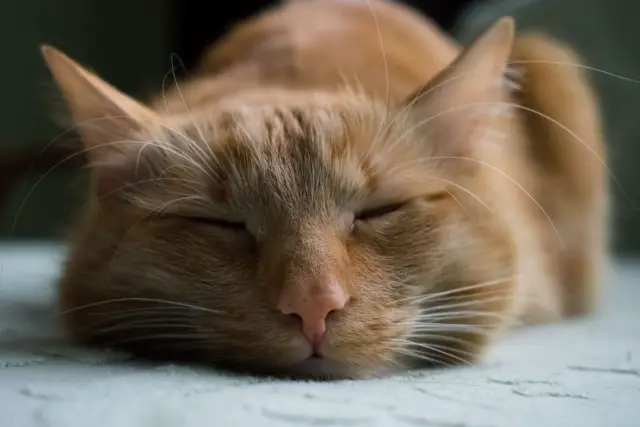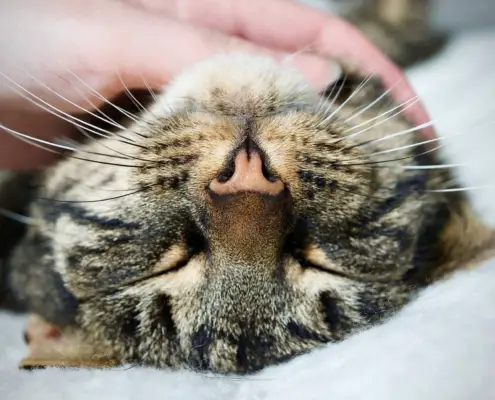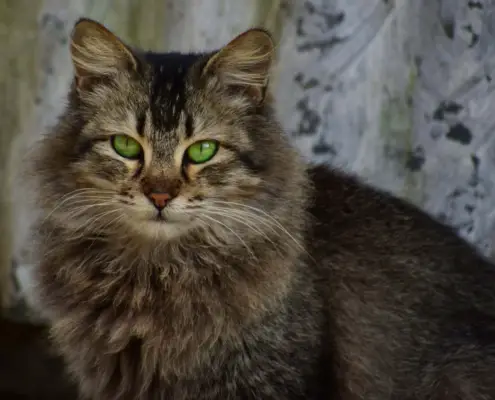
Cats have long captivated the hearts and minds of humans with their elegance, independence, and mysterious nature. While most people are familiar with the average-sized house cat, there are some felines that grow to enormous sizes, leaving us in awe. Have you ever wondered why some cats reach such colossal proportions? Well, prepare to be amazed as we delve into the fascinating science behind the extraordinary growth of these magnificent creatures.
Genetics and Selective Breeding: Understanding the Role of Genetics in Cat Size
Genetics play a significant role in determining the size of a cat. Just like humans inherit physical traits from their parents, cats also inherit genes that influence their size. Selective breeding, a process in which specific traits are favored during mating, has contributed to the development of large cat breeds. Breeders have carefully selected cats with desirable size characteristics and bred them together, gradually increasing the average size of the offspring over generations.
One famous example of selective breeding is the Maine Coon, known for its impressive size. These gentle giants can weigh between 15 to 25 pounds and reach lengths of up to 40 inches. Breeders specifically chose cats with larger frames and robust bone structures to create this majestic breed. Through the careful manipulation of genetics, breeders have successfully produced cats that defy the norms of size.
Environmental Factors: How Environmental Conditions Can Influence Cat Size
While genetics play a significant role, environmental factors can also impact the size of a cat. Adequate nutrition, a stimulating environment, and access to physical activity are essential for healthy growth. Cats that are raised in environments with limited space or poor nutrition may experience stunted growth. On the other hand, cats provided with spacious living areas, a balanced diet, and opportunities for exercise are more likely to reach their full size potential.
Additionally, the temperature in which a cat resides can affect its growth. Cold climates can stimulate an increase in body mass as cats develop a thicker layer of fur and store more fat to stay warm. Conversely, cats living in warmer environments may have a slight advantage in terms of growth due to increased metabolic rates. These environmental factors work in conjunction with genetics to shape the size of a cat.
Nutritional Considerations: Exploring the Impact of Diet on Cat Growth
Proper nutrition is crucial for the healthy growth and development of cats, regardless of their size. However, the specific dietary needs of large cats differ from those of their smaller counterparts. Large cat breeds require diets that are specifically formulated to support their unique growth requirements. These diets often contain higher levels of protein to promote muscle development and lower levels of carbohydrates to prevent excessive weight gain.
It is essential for owners of large cats to consult with their veterinarian to determine the most appropriate diet for their feline friend. Feeding a balanced and appropriate diet ensures that the cat receives the necessary nutrients for optimal growth while minimizing the risk of obesity and related health issues.
Hormonal Influences: The Role of Hormones in Cat Size
Hormones, the chemical messengers of the body, also play a role in the size of cats. The growth hormone, produced by the pituitary gland, is responsible for regulating the overall growth and development of an individual. Cats with higher levels of growth hormone may experience accelerated growth and reach larger sizes.
In addition to growth hormone, sex hormones such as testosterone and estrogen can influence cat size. Male cats typically grow larger than their female counterparts due to the effects of testosterone. Estrogen, on the other hand, can affect the size of female cats, particularly during their reproductive years. These hormonal influences contribute to the size variations observed among cats.
Health Issues: Uncovering Medical Conditions That Can Contribute to Cat Size
While large cat breeds are generally healthy, there are medical conditions that can contribute to excessive growth or size. One such condition is gigantism, a rare disorder caused by an excess of growth hormone. Cats with gigantism experience uncontrolled growth and can reach extraordinary sizes. However, it is important to note that gigantism is a medical anomaly and not a characteristic of all large cats.
Additionally, certain metabolic disorders or hormonal imbalances can lead to abnormal growth patterns in cats. These conditions may require medical intervention to regulate the cat’s growth and overall health. Regular veterinary check-ups are crucial for identifying and managing any underlying health issues that may contribute to a cat’s size.
Famous Large Cat Breeds: Highlighting Popular Cat Breeds Known for Their Size
Several cat breeds are renowned for their impressive size and stature. One of the most well-known large cat breeds is the Savannah cat. This breed is a cross between a domestic cat and a serval, a wild African cat. Savannah cats can grow to be quite large, with some individuals reaching weights of up to 25 pounds. Their unique appearance and size make them a popular choice among cat enthusiasts.
Another notable large cat breed is the Ragdoll. These gentle and affectionate felines can weigh between 10 to 20 pounds, with some individuals tipping the scales even further. Their large size, striking blue eyes, and silky fur make them a favorite among cat lovers.
Myths and Misconceptions: Dispelling Common Misconceptions About Large Cats
Despite their popularity, there are many myths and misconceptions surrounding large cats. One common misconception is that all large cats are aggressive or dangerous. In reality, size does not necessarily correlate with temperament. Large cat breeds can be just as loving and gentle as their smaller counterparts. It is important to judge a cat’s behavior based on their individual personality rather than their size.
Another myth is that all large cats require excessive amounts of space. While it is true that large cats benefit from ample room to roam and explore, they can adapt to living in smaller spaces with proper environmental enrichment. Providing vertical spaces, interactive toys, and scratching posts can help fulfill their need for physical and mental stimulation.
Tips for Caring for Large Cats: Providing Practical Advice for Owners of Giant Felines
Caring for a large cat comes with its own set of considerations. Here are some practical tips for owners of giant felines:
- Provide ample space: While large cats can adapt to smaller spaces, it is important to provide them with enough room to move around comfortably.
- Choose an appropriate diet: Consult with your veterinarian to determine the most suitable diet for your large cat’s specific needs.
- Regular exercise: Engage your cat in regular play sessions to promote physical activity and maintain a healthy weight.
- Regular veterinary check-ups: Schedule routine check-ups to monitor your cat’s health and address any issues promptly.
- Environmental enrichment: Provide toys, scratching posts, and climbing opportunities to keep your large cat mentally stimulated.
Embracing the Diversity and Wonder of Cat Sizes
In conclusion, the size of a cat is influenced by a combination of genetics, environmental factors, hormonal influences, and proper nutrition. Through selective breeding and the careful manipulation of genetics, breeders have produced large cat breeds that captivate our attention. While some medical conditions can contribute to excessive growth, it is essential to remember that not all large cats are affected by these anomalies. By understanding the science behind cat size, we can better appreciate the diversity and wonder of these magnificent creatures. So, whether you are the proud owner of a giant feline or simply an admirer of their grandeur, let us embrace and celebrate the various sizes that cats can grow to.
If you enjoyed my article, I would appreciate you sharing it with your network.

Sima Ndlebe
Sima writes for CatBuzz. He is interested in Cats, Health and Fitness, and Entrepreneurship.
Published: 17 November 2023




